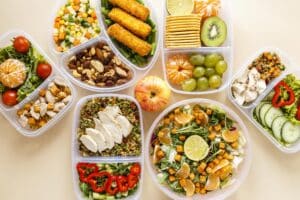Navigating the grocery store can feel like an overwhelming experience when you first start a grain-free diet. The aisles contain tempting treats and processed foods, many containing hidden grains. But don’t worry; with some knowledge and preparation, you can easily navigate the grocery store and find delicious, grain-free options with this expert guide to grain free grocery shopping
What is a Grain-Free Diet?
Before we dive into grain free grocery shopping tips, let’s quickly define a grain-free diet. A grain-free diet is an eating plan that eliminates all grains from your diet – this includes common grains like wheat, barley, rye, oats, and corn.
Why Choose a Grain-Free Diet?
A grain-free diet can have several potential health benefits. Some people believe that removing grains from their diet can help reduce inflammation, improve digestive health, and boost energy levels. A grain-free diet may also help with weight loss and blood sugar control.
Embarking on Your Grain-Free Journey
1. Start Small
Don’t try to change your entire diet overnight. Instead, replace one or two grain-based meals or snacks with grain-free options – this will give your body time to adjust and help you make the transition easier.
2. Educate Yourself
Before you start the grain free grocery shopping, take some time to educate yourself about different types of grains and their common aliases. This knowledge will help you identify hidden grains in processed foods and make more informed choices when grain free grocery shopping.
3. Read Ingredient Labels Carefully
Get in the habit of reading ingredient labels carefully. Even for seemingly obvious items like condiments or packaged snacks, grains can be hidden in unexpected places.
4. Plan Your Meals
Create a grocery list based on your meal plan – this will help you avoid impulse purchases and ensure you have all the ingredients.
5. Shop the Perimeter
Focus on the grocery store’s perimeter, where you’ll find fresh produce, meat, seafood, and other naturally grain-free options.
6. Explore Grain-Free Alternatives
There are many great grain-free alternatives available these days. For example, you can find grain-free bread, pasta, and flour.
7. Be Mindful of Hidden Grains
Be on the lookout for hidden grains. Common aliases for grains include wheat starch, maltodextrin, and hydrolysed vegetable protein.
8. Make Your Own Snacks
Instead of relying on packaged snacks, make your own from scratch. This way, you can control the ingredients and ensure they are grain-free.
Grain Free Grocery Shopping: Navigating the Grocery Aisles with Confidence

The grocery store can be a minefield of hidden grains, but with some know-how, you can confidently navigate the aisles and find delicious, grain-free options.
Common Hidden Grain Sources
When grain free grocery shopping, be mindful of these common sources of hidden grains:
Sauces and Dressings
Many sauces, dressings, and marinades contain hidden grains as thickeners or flavourings. Check the labels carefully and opt for grain-free alternatives.
Packaged Snacks
Granola bars, chips, crackers, and other packaged snacks often contain grains. Read labels carefully, look for grain-free options, or make your own snacks from scratch.
Processed Foods
Processed foods like frozen meals, canned soups, and deli meats often contain grains as fillers or preservatives. Check the labels and stick to whole, unprocessed foods whenever possible.
Beverages
Some beverages, such as malt beverages, beer, and certain flavoured syrups, contain grains. Stick to water, unsweetened tea, or coffee for grain-free refreshment.
Condiments
Some condiments, such as ketchup, soy sauce, and teriyaki sauce, may contain hidden grains. Check labels and choose grain-free versions, or make your own condiments.
Tips for Identifying Hidden Grains

As you embark on your grain free grocery shopping journey, remember these tips for identifying hidden grains:
- Pay attention to the ingredient list. Grains are listed by their common names, such as wheat, barley, rye, oats, or corn.
- Look for common aliases for grains, such as wheat starch, maltodextrin, and hydrolysed vegetable protein.
- Be aware of fillers and thickeners, which are often made from grains.
- If you need clarification on an ingredient, check with the manufacturer or a reliable source.
A Ketology Reminder:
Transitioning to a grain-free diet can be a positive step towards a healthier lifestyle. Following these expert grain free grocery shopping tips and embracing grain-free alternatives, you can enjoy delicious and nutritious meals without compromising taste or variety.
Remember, the key is to be informed and make informed choices.
Check out our resources for more lifestyle tips!




